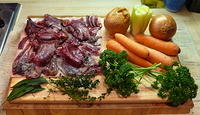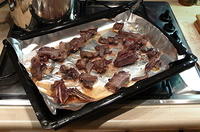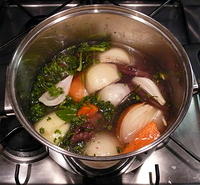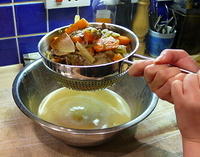Note: This entry has been restored from old archives.
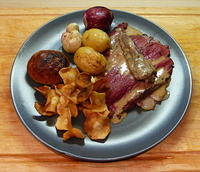
Last weekend I covered the stock I made with the hare offcuts and forelegs, now I’ll get on with a description of the prime meal our hare gave us: Roast Saddle of Hare. This is the second recipe (in this case maybe production is a more accurate term) in my Harey Weekend series. I took a rather straightforward path with this one, marinating the saddle for a couple of hours in herby olive oil, barding with streaky bacon, and roasting it along with some garlic, onions and new potatoes. I also prepared steamed yeasty, herby dumplings, making up a recipe on the spot for them, and crispy parsnip chips.
As far as cooking times and general information goes, the books I consulted were the usual The River Cottage Meat Book, as well as The Game Cookbook
. Both were a little light on roasting information unfortunately, my approach to roasting the beast was mainly informed by the Meat Book though I extended the time given by Hugh just a little (and I don’t think you’d want the hare any rarer than we had it.) I also took Hugh’s advice on board and didn’t marinate (“pickle”, he says) the meat in wine beforehand, choosing instead plenty of oil. The Game Cookbook, as usual for game, provides the better and most complete back-story on the history of eating, and mythology of, hares. While The Meat Book, I found, gave slightly better detail on working with the hare. Clarissa gives many more recipes than Hugh though, The Meat Book has only a single hare recipe: Jugged Hare. Which is the classic hare dish, there’s a version in both books and they’re very different. The instructions I have here are, I believe, sufficient for the roasting – so if you’re after a book that gives hare a more detailed coverage I’d recommend The Game Cookbook
out of the two.
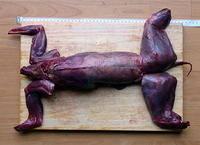
As far as the timing goes the first thing I did was marinate the hare about two hours before roasting it and then prepared the dumpling dough. Next, 30 minutes before roasting the saddle, I put the potatoes into the hot (200°C) oven to pre-roast a little. Just prior to roasting I unwrapped and barded the saddle and stuck it into the oven, which was boosted to 220°C, and threw the onions and garlic in with the potatoes. Total hare roasting time was only about 25 minutes, though the vegetables stayed in the oven for a further 20 minutes after the hare was removed. The final 20 minutes was the busiest, hare out of the oven, dumplings into the steamer, parsnips chips shallow-fried in batches, juices reduced with added double cream for a sauce. Around 3 hours end-to-end but only the last hour was particularly busy.
A 600g hare saddle serves two well and could do three at a pinch, but would be stingy for four (get two saddles then.) We got enough meat out of this for dinner and, thanks to plenty of sides, had a little left over for a salad the next day. For a larger roast (to serve four comfortably) you could include the rear legs, which are very meaty. It’s said that they tend to be dry though and work better for a casserole, which is what I did.
Anyway, the first thing I did was…
Marinating the Saddle
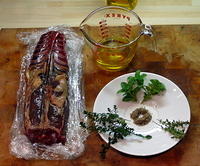
The butcher had jointed the hare for me, as shown in earlier photos, but the saddle still had some rough ends and the full rib enclosure, as well as the liver (lucky us to have an understanding butcher!) I cleaned up each end of the saddle, trimming away any loose meat and taking the cleaver to the neck end to remove it at the first rib. I entirely trimmed off the flaps of belly and cut through the rib cage all the way down to the meaty back, I used poultry shears to do this. The saddle and ingredients to the marinade are shown to the right (the garlic and juniper berries are missing.) The liver is still attached in that photo, however I carefully removed it and put it aside (to be used in the next recipe in this series.)
Hare has a rather tough membrane under the skin on the back and I wasn’t sure if I should remove this or not. In the end I decided not to and since the hare turned out so well I’ll stick with this approach in future. It means that marinating the hare may not be so effective maybe, but maybe the membrane does a good job of keeping the meat so moist and succulent! What I did do was thoroughly clean off any traces of hair and blood under a trickle of water then pat the saddle dry with plenty of paper towels.
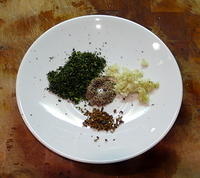
The ingredients for the marination are:
- 1 ~600g
- hare saddle
- ⅓ cup
- 50/50 light and extra-virgin olive oil
- 3 sprigs
- lemon thyme (4 o’clock above, 10 to right)
- 3 sprigs
- common thyme (7 0’clock above, 10 to right)
- 3 sprigs
- oregano (12 o’clock above, 10 to right)
- 2
- garlic cloves (2 o’clock to right)
- 6
- juiper berries (6 o’clock to right)
- 1tsp ground
- black pepper (centre of both photos)
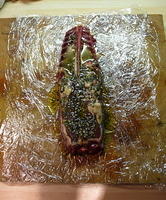
The preparation of herbs and spices is shown in the photo to the right, they were all fairly finely chopped. Then the herbs were added to the olive oil and ⅓ of the oil spread onto a sheet of plastic wrap big enough to thoroughly wrap up the saddle. The saddle was placed on this oil then another ⅓ was rubbed all over it before tipping the final ⅓ over the top and thoroughly wrapping it up. This was left to sit in a corner, after an hour I turned it over and at the same time made the dumpling dough…
Yvan’s Yeasty Herby Dumplings
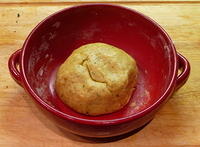
This dumpling recipe is something I just threw together, it’s pretty simple. All the dumpling recipes I could find in the books I have either used baking soda or no raising agent at all, I wasn’t so happy with this idea and decided to try a yeasty butter dough instead, it worked out well. This recipe made enough for two little dumplings each to go with the hare (but we left one each for the next day) plus two more each to go with the casserole I later made with the hind-legs.
I’ve pulled this recipe out as separate from the roasting to reduce the overall complexity of this entry. However the dumplings were prepared and cooked at the same time as the roast, see the timeline at the bottom of the entry.
- 5g
- dry yeast
- 150g
- plain flour
- 50g
- unsalted butter (room temperature or it’ll be too hard)
- 20g
- extra virgin olive oil
- 5 sprigs
- lemon thyme
- 3 sprigs
- oregano
- 1/2tsp
- salt
- 1tsp
- ground pepper
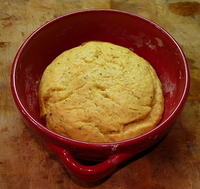
First, about 5 minutes in advance, put the yeast in a small ceramic dish and add about 30ml of lukewarm water. Once the yeast has turned frothy you can get on with making the dough. Into a separate dish place the flour, butter, and EVOO. Rub together with fingertips until well combined – the consistency should be crumbly and granular (“like breadcrumbs” the books usually say, it’s not a very accurate description I think.) Pull the leaves off the fresh herbs and chop finely, then add to the flour mixture. Also add the salt, pepper, and yeast liquid. Mix together well, with hands, until a soft dough is formed. I’ll cheat here and say the dough “should be like a soft shortcrust pastry dough”, and thus leave those who don’t make pastry mystified! It should almost be sticky, but not quite. It must be kneedable, since that’s what you’ll do next. Give it a 5 minute kneed on a smooth surface (since the dough is oily the surface shouldn’t need flouring or oiling.) If you do find it is too gooey carefully add more flour, alternately, if it seems too stiff add a little lukewarm water.
Ball up the dough and place into a bowl that’s a good three times the size of the dough-ball. Cover by placing inside a shopping bag and leave in a warm spot for an hour.
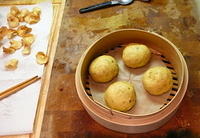
Just before you get on with preparing the hare (after putting the potatoes in the oven, see below) pull out the dough and give it a good kneed before breaking it into 8 evenly sized pieces and ball them up. To make the balls I pinch the dough into the bottom to avoid having creases on top, which would open up during cooking. These balls just sat up the back of my chopping board to puff up a little while I prepared the rest of the roast (you can see them sitting there in the parsnip photo below.)
As soon as the saddle was removed from the oven (below) I got four of the dumplings into a bamboo steamer over some simmering water in a wok. They steamed for 10 minutes and were then removed to a plate and plonked under an overhead grill to crisp up while I finished off the sauce and presented the rest of the meal for serving. Be careful here! I crisped them up a little too much, but they were fine. See the photo at the end of this entry, or the beginning. The four uncooked dumplings went into the fridge to be cooked another time.
The roasting, shallow-frying, and reducing
The main event, yet the least complicated! The roasting of the saddle is actually very quick to get the lovely rare and juicy end-product I was after, but the total roasting time was somewhat longer as required by the vegetables. The inputs to roasting (and sauce, and parsnip chips) were:
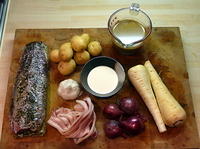
- 8
- new potatoes
- 4
- small red onions
- 1 whole head
- garlic
- 1 ~600g
- marinated hare saddle
- 6 rashes
- unsmoked streaky bacon
- plenty
- light olive oil for the vegetables
- 1 medium
- parsnip (two are shown, but I only used one)
- plenty
- groundnut (peanut) oil for shallow-frying
- 250ml
- rich hare stock (prepared earlier)
- 50ml
- double cream
Roasting
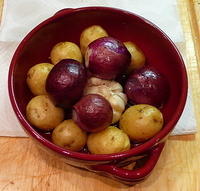
Pre-heat the oven to 200°C and get plenty of lightly salted water into a saucepan on the stove and bring it to a boil. Throw the potatoes into the boiling water for 5 minutes then drain and let dry in a colander. When the potatoes are dry (help them a little with a tea-towel maybe) place into an oven-proof dish into which they’ll fit fairly snugly with just enough room for the onions and garlic to be added later. Coat well with oil and let about 5mm of oil sit in the bottom of the bowl, grind over pepper and salt then into the oven for 30 minutes!
When the 30 minutes is up pull the sizzling potatoes out and toss in the oiled up onions and head of garlic, straight back into the oven with this lot and turn it up to 220°C.
Now remove the hare saddle from the plastic wrap and place back-upwards in a roasting pan. Bard it with the streaky bacon, a typical rasher will be the perfect length to place lengthwise down the saddle (photo lower-right.) I plated each strip over the other working from the bottom up, then wrung all the excess oil out of the plastic wrap over the top of this.
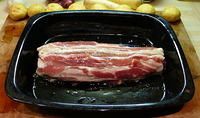
The saddle now goes into the 220° oven to sizzle, but a mere 10 minutes later you pour the stock into the pan (not over the saddle) and turn the dial down to 160°C. A further 15 minutes and the saddle is done! This will give you rather pink meat as shown in the photo at the end of this entry, if you want it less pink go another 10 minutes (bit I think it’d be a shame.) Pull the saddle out of the oven and put out of the way in a corner while you finish off everything else. Leave the oven on with the vegetables in it, until either you’re ready to serve or you have to displace them to brown the tops of your dumplings. While the saddle was roasting you were simultaneously sorting out those parsnip chips…
Shallow-Frying
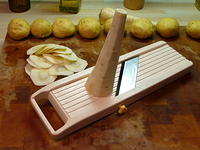
The best way to make the chips shown is to use a mandoline to slice the parsnip really, around 1mm, thin (I have a cheap Benriner mandoline that I’m happy with so far, there’s many to choose from though.) You could also do this with a nice sharp knife, but it’s hard going! Yet another approach is to use a peeler to make long chips by peeling through the parsnip down its length, this is the way I remember my mum doing it and it can result in quite attractive curly/twisty chips!
To do the shallow-frying put plenty of oil (at least 2cm deep) into a small frypan or saucepan. Heat this oil up until the point where a bit of parsnip dipped into it will bubble vigorously. Shallow-fry the parsnip in batches so that the pieces only overlap a little at most, it took three batches for me to do one parsnip in a 19cm pan.
Fry them until they start to turn golden around the edges then carefully flip them all over. When they’re golden all over remove them from the oil and place on some paper towels to de-oil, when they’re all done sprinkle with a little salt. I recommend using chopsticks to flip and remove the chips – make sure they’re not varnished ones though! Be very careful with very hot oil, one small safety measure I employ is to always make sure I use one of the rear burners on the stove for heating oil.
Reducing
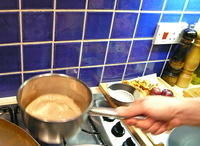
We’re almost done. The vegetables are probably out of the oven now, the dumplings under the grill, the chips sitting on paper towels, and the saddle resting in a corner.
All we need now is a sauce, this is an easy one! Pour the juices from the roasting dish through a sieve into a small saucepan and add the double cream. Get this bubbling away vigorously and reduce until it has the consistency of thickened cream. That’s it, easy like I said. Pour into a dish with a spoon, or a small pouring jug, for serving.
It All Comes Together
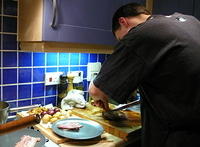
It’s really been a crazy marathon up to this point, at peak I had three different things going on at once (roasting hare & veggies, steaming dumplings, and shallow-frying parsnip chips.) Things are coming together nicely now, the hare saddle will have been out of the oven for about 20 minutes but still be warm and ready for carving.
The first thing I did was cut off about 3 inches at the narrow end of the saddle, including the barding bacon. This I put aside to be used the next day. Then I lifted the strips of bacon off the remaining bulk of the saddle and laid them down on the serving plates (which had been in the oven to warm for a short while.) Now take a nice sharp knife and carve good 3 to 5mm thick slices off the back of the saddle, you may wish to peel off the membrane first but I didn’t bother (it should come away easily if you choose to remove it.) You’ll get 4 or 5 nice slices off each side. I laid these out over the bacon, this can kind of be seen in the photo to the right if you look at the larger version.
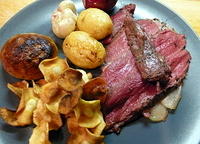
When you’ve carved strips off each side down to the bones, flip the saddle over and carve out the two inner fillets. These inner strips of meat are equivalent the fillet-steak of beef, they really were the most delicious little morsels of hare meat too. Lay out each little fillet over the top of the slices of meat on the serving plate (the strip laid at 90° to the rest of the meat in the adjacent photo.)
Now add an onion, a couple of potatoes, a dumpling or two, half a head of garlic, and a handful of parsnip chips. You can drizzle some sauce over the lot, or leave this to be done at the table.
Serve!
This hare was probably the best bit of meat I’ve eaten in my life, it was that good. I’ve already praised its virtues though, so I won’t go on any further. The dumplings were interesting and turned out quite well, rather light, rather buttery and certainly yeasty. They retained the lemony flavour of the thyme and did their job well: sauce mops.
We enjoyed our harey roast with a good organic dry scrumpy cider and this teamed up well with the flavour of the meat and overall richness of the meal. If it was to be wine I’d probably go for a lighter red, maybe a pinot noir.
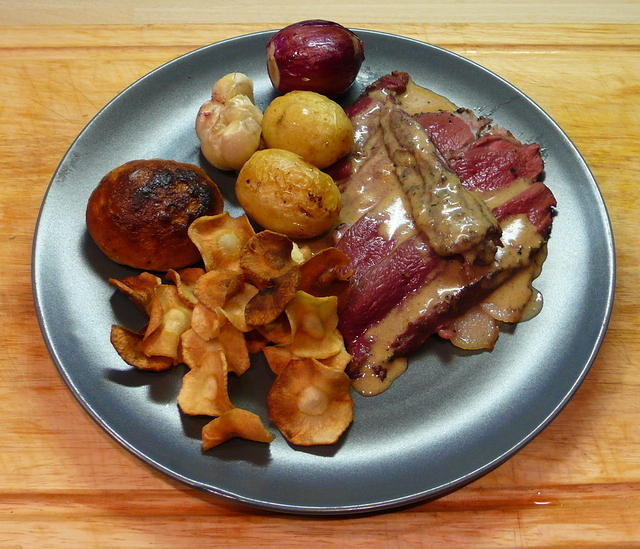
Tail of the Hare
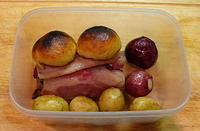
Along with the excess 3 inches of saddle we had 4 potatoes, 2 onions, 2 dumplings, and about 2 tbsp of sauce left over for another time. Most of this went into the harey salad I prepared for lunch the following day, which is a recipe for another time (next in my harey series.) The leftover dumplings actually got sliced up and pan-toasted with eggs for breakfast the next day, so didn’t make it to the salad. The four uncooked dumplings sat wrapped in plastic in the fridge alongside the hare hind legs until used in the final recipe in the series, a harey casserole.
I picked at the filleted bones and nibbled off any larger chunks of meat, I couldn’t help myself. Then the bones went into a freezer bag and joined some other leftovers on the “stock shelf” in the freezer.
As usual there’s a full album of photos for this recipe including many I couldn’t reasonably fit alongside the words.
Finally, here’s a rough timetable to give an idea of how all the above fits together. It isn’t exactly the timing I followed but it’s a close enough blueprint (I actually made the dough way too early, but that’s completely unnecessary.)
- 18:00
- marinate hare
- 19:00
- flip hare and make dumpling dough
- 19:30
- potatoes into the 200°C oven
- 19:35
- kneed dumpling dough and make individual dumplings
- 20:00
- onions & garlic & hare into the 220°C oven, slice the parsnip
- 20:10
- pour stock into hare and reduce temperature to 160°C
- 20:15
- start shallow-frying the parsnip, get water steaming in wok
- 20:25
- remove hare from oven, start steaming dumplings
- 20:35
- move steamed dumplings to grill, remove vegies from oven
- 20:40
- start reducing pan juices mixed with double cream
- 20:45
- slice hare, present everything on plates, serve!
